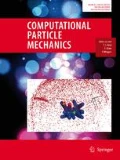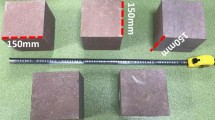Abstract
In this study, the combined finite–discrete element method (FDEM), which merges the finite element-based analysis of continua with discrete element-based transient dynamics, contact detection, and contact interaction solutions, is used to simulate the response of a flyer plate impact experiment in a Westerly granite sample that contains a randomized set of cracks. FDEM has demonstrated to be a strongly improved physical model as it can accurately reproduce the velocity interferometer system for any reflector plot and capture the spall region and spall strength obtained from flyer plate experiments in granite. The number and the distributions of preexisting fractures have also been studied to get better understanding of the effect of structural cracks on the mechanical behavior and the failure path of Westerly granite under high strain rate impact. These FDEM capabilities, in the context of rock mechanics, are very important for two main reasons. First, the FDEM can be further applied to many complex large-scale problems such as planetary impact, rock blasting, seismic wave propagation, characterization of material failure around explosive crater formations, and detection of hydrocarbon flow in petroleum industry. Second, it can be used to validate high strain rate impact experiments and essentially, via virtual experimentation, replace these high-cost experiments by very cost- and time-effective simulations.















Similar content being viewed by others
References
Yuan F, Prakash V (2013) Plate impact experiments to investigate shock-induced inelasticity in Westerly granite. Int J Rock Mech Min Sci 60:277–287
Prakash V (1995) A pressure-shear plate impact experiment for investigating transient friction. Exp Mech 35(4):329–336
Zhao H, Gary G (1995) A three dimensional analytical solution of the longitudinal wave propagation in an infinite linear viscoelastic cylindrical bar. Application to experimental techniques. J Mech Phys Solids 43(8):1335–1348
Liu H, Kou S, Lindqvist P-A, Tang C (2002) Numerical simulation of the rock fragmentation process induced by indenters. Int J Rock Mech Min Sci 39(4):491–505
Wang S, Sloan S, Liu H, Tang C (2011) Numerical simulation of the rock fragmentation process induced by two drill bits subjected to static and dynamic (impact) loading. Rock Mech Rock Eng 44(3):317–332
Saksala T (2010) Damage–viscoplastic consistency model with a parabolic cap for rocks with brittle and ductile behavior under low-velocity impact loading. Int J Numer Anal Methods Geomech 34(13):1362–1386
Thuro K, Schormair NJ (2008) Fracture propagation in anisotropic rock during drilling and cutting. Geomechanik und Tunnelbau 1(1):8–17
Forquin P, Hild F (2010) A probabilistic damage model of the dynamic fragmentation process in brittle materials. In: Advances in applied mechanics, vol 44. Elsevier, pp 1–72
Rougier E, Knight EE, Broome ST, Sussman AJ, Munjiza A (2014) Validation of a three-dimensional finite-discrete element method using experimental results of the split Hopkinson pressure bar test. Int J Rock Mech Min Sci 70:101–108
Shockey DA, Curran DR, Seaman L, Rosenberg JT, Petersen CF (1974) Fragmentation of rock under dynamic loads. In: International journal of rock mechanics and mining sciences and geomechanics abstracts, vol 8. Elsevier, pp 303–317
Munjiza AA (2004) The combined finite-discrete element method. Wiley, Hoboken
Munjiza AA, Knight EE, Rougier E (2011) Computational mechanics of discontinua. Wiley, Hoboken
Munjiza AA, Rougier E, Knight EE (2014) Large strain finite element method: a practical course. Wiley, Hoboken
Munjiza A (1992) Discrete elements in transient dynamics of fractured media. Swansea University, Swansea
Gao K, Euser BJ, Rougier E, Guyer RA, Lei Z, Knight EE, Carmeliet J, Johnson PA (2018) Modeling of stick-slip behavior in sheared granular fault gouge using the combined finite–discrete element method. J Geophys Res Solid Earth 123(7):5774–5792
Lei Z, Rougier E, Knight EE, Munjiza AA, Viswanathan H (2016) A generalized anisotropic deformation formulation for geomaterials. Comput Part Mech 3(2):215–228. https://doi.org/10.1007/s40571-015-0079-y
Munjiza A, Rougier E, John NWM (2006) MR linear contact detection algorithm. Int J Numer Methods Eng 66(1):46–71. https://doi.org/10.1002/nme.1538
Munjiza A, Andrews K (1998) NBS contact detection algorithm for bodies of similar size. Int J Numer Methods Eng 43(1):131–149
Knight E, Rougier E, Munjiza AJP, LA-UR-13-23409 (2013) LANL-CSM: Consortium proposal for the advancement of HOSS.05-09
Rougier E, Knight E, Munjiza AJP, LA-UR-13-23422 (2013) LANL-CSM: HOSS-MUNROU Technology Overview.05-10
Knight E, Rougier E, Lei Z (2015) Hybrid optimization software suite (HOSS)-educational version. In: Technical report LA-UR-15-27013. Los Alamos National Laboratory
Rougier E, Munjiza AA (2010) MRCK_3D contact detection algorithm. In: Paper presented at the proceedings of 5th international conference on discrete element methods. London
Knight E, Rougier E, Lei Z (2015) Hybrid optimization software suite (HOSS)—educational version. Technical Report LA-UR-15-27013, Los Alamos National Laboratory
Saadati M, Forquin P, Weddfelt K, Larsson PL, Hild F (2015) A numerical study of the influence from pre-existing cracks on granite rock fragmentation at percussive drilling. Int J Numer Anal Methods Geomech 39(5):558–570
Tatone BSA, Grasselli G (2015) A calibration procedure for two-dimensional laboratory-scale hybrid finite–discrete element simulations. Int J Rock Mech Min Sci 75(3):56–72. https://doi.org/10.1016/j.ijrmms.2015.01.011
Acknowledgements
The Los Alamos National Laboratory LDRD Program (Project #20170103DR) supported this work. Technical support and computational resources from the Los Alamos National Laboratory Institutional Computing Program are highly appreciated. Our data are available by contacting the corresponding authors.
Author information
Authors and Affiliations
Corresponding author
Additional information
Publisher's Note
Springer Nature remains neutral with regard to jurisdictional claims in published maps and institutional affiliations.
Rights and permissions
About this article
Cite this article
Chau, V., Rougier, E., Lei, Z. et al. Numerical analysis of flyer plate experiments in granite via the combined finite–discrete element method. Comp. Part. Mech. 7, 1005–1016 (2020). https://doi.org/10.1007/s40571-019-00300-w
Received:
Revised:
Accepted:
Published:
Issue Date:
DOI: https://doi.org/10.1007/s40571-019-00300-w




